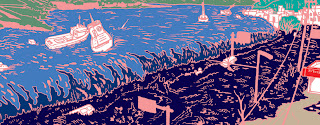Sunday, June 26, 2011
Friday, June 24, 2011
Kafka on the shore-1
I tried to do a series of illustrations for Haruki Murakami's fiction "Kafka on The Shore". As a reader of Murakami's books, it's a exciting challenge that watching me to build up the story through my works. However, this was also the most difficult text I have ever worked with. As long as you had ever read his fictions, you couldn't get rid of that layers and layers of metaphors weaved in between the story, such as different time and spaces interlace with each other. Or, to put it more clearly, in this case, the son makes love with his biological mother's teenage spirit, in dreams.
“佐伯小姐跨倒仰臥的你身上,張開腳,將你堅硬得像石頭的陰莖導入自己裡面。你無法選擇。她這樣選擇。她扭著腰像畫圖般深入。她直直的頭髮垂到你肩上,像柳枝般無聲地搖著。你逐漸被吞進柔軟的泥中。世界的一切是溫暖濡濕而不分明的,在那裡面只有你的陰莖是堅硬光澤的存在。你閉上眼睛作你自己的夢。時間的經過變得非常不明確。漲潮、月昇⋯”
海邊的卡夫卡(下) 第29章 P.79
處理性愛場面是我很少碰觸的。在決定描述這場景之前歷經多次掙扎,但是身為主人翁的卡夫卡與母親近乎“神交”的情節,是此書極為重要的段落,這才完成了此書所奠基的希臘悲劇精神。故事中,男孩卡夫卡透過一張母親年輕時灌錄的唱片與母親年輕的靈魂相遇,而一天晚上,現實的母親終於到來,決定了這場亂倫。我讓男孩蓋上被單與母親交合,表示他的被動性,而底下的唱盤轉動,遂成暗潮洶湧的海水,帶領兩人陷入情慾與命運的漩渦而不可自拔。
Friday, June 10, 2011
The making of "Tsunami"/part 3.
這本書的封面,或者說是正面,是代表著歷史當中的《現在》,指的也就是這次的日本大海嘯。我在為其他作業搜尋資料的時候,曾看到過一張攝人的照片:某鎮提防外的河水因為海水倒灌的關係,滿溢出了堤頂,照片捕捉到的是大水正在溢出的當下,這比任何淹水的照片都令我感到恐懼。
我決定用幾張不同的、本次災難記錄下的照片,合成一幅橫向長形的圖片,然後用描圖紙一筆一筆重新描繪出這個虛擬卻又真實的場景。至於形式上,除了我一直都對於長形的畫很感興趣,也是對東方文化的呼應;如同《清明上河圖》、或是最近很夯的 《富春山居圖》,只是印象中文人畫極少描繪災難,然而災難幾乎是我們今日的日常風景了。
(待續)
Wednesday, June 1, 2011
The making of "Tsunami"/part 2.
內頁插圖底稿:人魚-1
At the beginning, I knew I will need a horizontal and long image for my cover. This main image should be the most important element in the book, and literally records the shocking scenes of the tsunami tragic. Then, here is the point: what kind of contents should I put in the book to correspond the cover? I think that human beings not only use scientific numbers to record disasters, but also, even more, with legends, myths and subtle traces in cultures. And if the cover of the book is sorrowful, can the interior of the book be something that cheering, for we people?
一開始,我就決定這本書需要一張橫向長幅的圖,作為主視覺,不僅僅是整本書最顯眼的主角,這張圖也將紀錄此次海嘯令人愕然無語的景象。重點是書的裡面我要放什麼來與這個主題、以及主圖相應。人類對於自然災害的紀錄傾向,不只是透過科學文字與數據,更多的還可能是傳說、神話以及許多文化裡面所留下的遺跡。如果說封面的主圖是令人沈痛的,那麼內頁的故事是不是能夠有些令人會心一笑的元素?
The first thing I thought of was the mermaid. In old myths, mermaids like to seduce exhausted sailers with their beautiful and exotic vocals. In a dark, foggy night, the ship is missing, and then follows the voice of mermaids to somewhere no one knows. The tales of mermaids are always related to their convincing voices. If we can have one mermaid as the coast line watcher, and can ask people to evacuate when disasters come, then no one will be killed. The mermaid here also put on the uniform of Japanese female tour guide. So the character can be more into Japanese cultural contexts.
我首先想到的就是人魚。航行在夜霧濃重的陌生海域,水手們疲倦且不安,居心不良的海妖人魚們,開始唱起迷惑人心的歌,整艘船就隨著人魚的歌聲開往不知道哪裡去了。傳說人魚的聲音極具誘惑力,這是她們的武器;然若人魚能夠擔任海岸守望的工作,每當颱風或是海嘯來襲時,警告沿岸居民趕緊撤離或是嚴禁圍觀,那麼所有人應該都會乖乖聽話,傷亡絕對能減輕。同時,我也讓人魚穿上日本車掌小姐的制服,讓角色更進入脈絡。
內頁插圖底稿:人魚-2
(待續)
Subscribe to:
Comments (Atom)






















